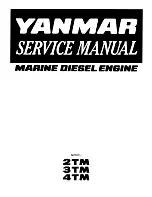
COOLANT SYSTEM
Bilge Pump and Strainer Components and Functions (Optional)
12/05
6LY3 Service Manual
7-21
© 2007 Yanmar Marine International
Bilge Pump Characteristics
Discharge Capacity at 0 m lift: 20 L (5.2 gal) or
more.
Automatic Feed Height: 1 to 2 m (3.2 to 6.4 ft) or
more.
Automatic Feed Time: 2 to 5 seconds.
(Limit for automatic feed time for a new pump in
primed condition: approximately 1 second.)
Automatic Shut-Off: Air intake causes negative (-)
pressure triggering automatic shut-off.
Bilge Pump Insulation
Insulation resistance: 500V with a mega tester
when the difference between the continuity point
and the body is 1 M
Ω
or greater.
Insulation proof stress: AC50 between the
continuity point and the body, or 60 Hz 500V for 1
minute when impressed current leakage is 10 mA
or lower.
Bilge Pump Durability
Rated voltage when there is 3% saltwater 60 L +
engine oil 3%, and operation is at 1800 cycles and
there are no difficulties.
Bilge Pump Vibration Proof
• Amplitude 0.51 mm (0.02 in.) (one side of the
amplitude)
• Vibration frequency of 10-55 Hz
• Sweep time 90 seconds
• Direction of vibration each direction 4 hours
• No difficulties after test period
Bilge Pump Precautions
Never run the pump dry. Be sure the strainer is
submerged in the bilge water before activating. If no
water is being drawn up after a period of 10
seconds, prime the pump. (Do not cavitate the
pump for longer than 10 seconds.)
When the pump has not been used for a long
period of time, the inside of the pump will loose its
prime. Before reusing, clean the inside of the pump
and prime it to ensure that it is wet. Check that the
pump is discharging water correctly.
Bilge water that is left in the hoses, pickup strainers
and pumps will freeze in cold temperatures. Take
care to ensure that all residual water is completely
discharged from the bilge pump system in
temperatures below 0°C (32°F). If necessary, use a
steaming towel to thaw frozen lines and
components. The pump will require an additional 5
to 10 seconds to operate in freezing temperatures.
The pump can be run continuously for a period of
10 minutes. After this time it must be shut off for a
period of 2 hours before reuse.
NEVER use the pump for showering. If the pump
outlet is modified for showering, the increase in
water pressure will cause the pump motor to seize.
NEVER use the pump to drain off rain water or
large amounts of water.
NEVER submerge the pickup strainer in bilge
sludge. Position the strainer about 20 mm (0.8 in.)
above the sludge. Clear the pump of all sludge
before shutting the bilge pump down.
Ensure that the battery is properly charged with a
specific gravity of 1.25 or more.
Installing the Bilge Pump
1. Select a dry place above the bilge water level.
2. Select the location for the bilge pump, taking
into consideration the length of the switch cable,
its attachment point and the position of the
battery.
3. Orient the pump at 45° with the impeller on the
low end and the nozzles facing up. Select a
position approximately 50 to 70 cm (20 to 28
in.) from the bottom of the boat.
4. Keep the cord terminal away from the water.
Water inside the terminal or switch may lead to
damage. Use caution to avoid cuts or nicks in
the insulation of the cord to prevent water from
entering.
Assembling the Switch
1. Attach the switch in a dry place with easy
access.
2. Connect the pump to the battery. (No more than
three lengths of the existing cable can be used
to extend the pump cables.)
















































